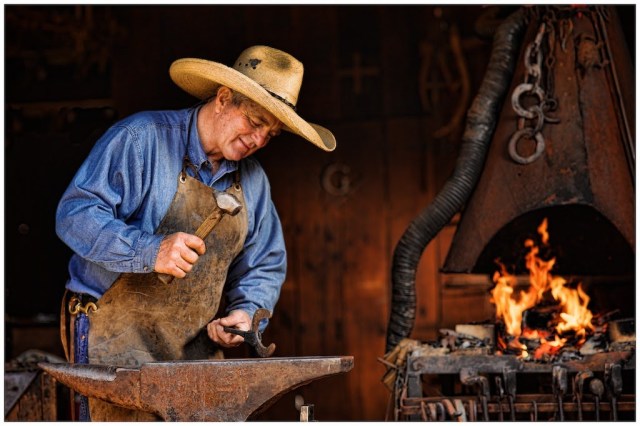A blacksmith is a metalsmith who creates objects from wrought iron or steel by forging the metal, using tools to hammer, bend and cut. Blacksmiths produce objects such as gates, grilles, railings, light fixtures, furniture, sculpture, tools, agricultural implements, decorative and religious items, cooking utensils and weapons. The place where a blacksmith works is called variously a smithy, a forge or a blacksmith's shop.
While there are many people who work with metal such as farriers, wheelwrights, and armorers, the blacksmith had a general knowledge of how to make and repair many things, from the most complex of weapons and armor to simple things like nails or lengths of chain.
Blacksmiths work by heating pieces of wrought iron or steel until the metal becomes soft enough for shaping with hand tools, such as a hammer, an anvil and a chisel. Heating generally takes place in a forge fueled by propane, natural gas, coal, charcoal, coke, or oil. Some modern blacksmiths may also employ an oxyacetylene or similar blowtorch for more localized heating. Induction heating methods are gaining popularity among modern blacksmiths.
Color is important for indicating the temperature and workability of the metal. As iron heats to higher temperatures, it first glows red, then orange, yellow, and finally white. The ideal heat for most forging is the bright yellow-orange color that indicates forging heat. Because they must be able to see the glowing color of the metal, some blacksmiths work in dim, low-light conditions, but most work in well-lit conditions. The key is to have consistent lighting, but not too bright. Direct sunlight obscures the colors.
The techniques of smithing can be roughly divided into forging. Forging is the process which use to shape metal by hammerin. It differs from machining in that forging does not remove material. Instead, the smith hammers the iron into shape. Even punching and cutting operations by smiths usually re-arrange metal around the hole, rather than drilling it out as swarf.

